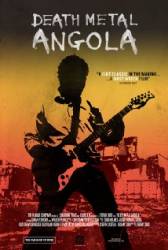 Text by Ned Sublette (from Nedslist)
Text by Ned Sublette (from Nedslist)
There’s a nonfiction film playing in NYC this week (and some other cities) that offers a rare view inside Angola, a country that is largely closed to outside reporters.
Jeremy Xido’s Death Metal Angola takes place in Huambo (in the country’s interior, founded as Nova Lisboa, a colonial railroad terminal, in the early 20th century.) Unfortunately for its residents, Huambo was a UNITA stronghold; Jonas Savimbi declared it to be his capital. So it was bombed practically out of existence, from the ground (including street-to-street battles) but mostly from the air, by the MPLA (i.e., by the Angolan government) and was in ruins from about ’94 on. Now the guns are silent; the Angolan Civil War ended in 2002.
That’s not what the movie’s about, but that’s the background that explains the movie’s landscape. DMA follows the attempt to stage Angola’s first death metal festival, with Angolan bands, at an orphanage for boys (the movie’s unanswered question is: what happened to the girls?) in Huambo. The performance footage is compelling — the cathartic effects of this style of music have never been better displayed. And I take my hat off to anyone who can make a movie in Angola.
About the film
Title: DEATH METAL ANGOLA (Rated R)
Year: 2012 – USA|Angola
Language: Portuguese (w. English subtitles)
Length: 90 minutes
Director: Jeremy Xido
Venue: Cinema Village (NY)
International Award-winning DEATH METAL ANGOLA follows a loving Angolan couple, Sonia and Wilker, whose love for death metal music is bringing hope to the town and children of Huambo, and Angola as a country. The devastating reality of Angola’s history of wars, and civil unrest has left the country’s people torn, broken, and starving for something to give them peace. Sonia, and Wilker’s dream to put on the first national rock festival ignites the emotions of the Angolan people, and helps them heal from the war stricken path Angola has left behind.
This engaging reality of Angola touches the heart of the viewer, and sheds new light on a music genre that is not well understood.

